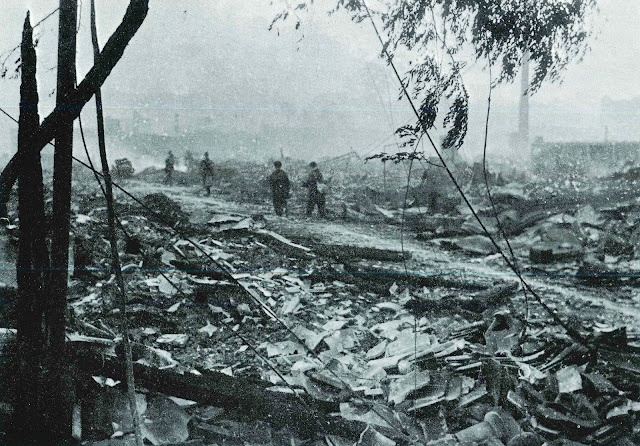In the early morning hours of August 10, 1945, the day after the Nagasaki atomic bomb exploded on August 9, 1945, the area around the Catholic Nakamachi Church collapsed and burned down after the bombing. It was located about 2.5 meters south-southeast of the hypocenter of the Nagasaki atomic bomb. The area was completely destroyed by a second fire and the whole area was burnt to the ground. The heat rays from the atomic bomb caused combustible materials to ignite and reignite, leading to a huge fire. The Catholic Nakamachi Church was destroyed by the atomic bombing of Nagasaki on August 9, 1945, leaving the outer walls and steeple.
The situation in Nagasaki was different from other air raids in that the entire city was instantly turned into a burnt earth by the blast and the fire. Efforts to extinguish the fire and the medical team's efforts to rescue the victims were chaotic. As we waited for the time to pass, a small number of Nagasaki citizens who had survived because of their location gathered to search their homes and relatives. The Nagasaki atomic bomb was dropped at 11:02 a.m. on August 9, 1945, and exploded, killing or injuring about 120,820 people and setting about 18,409 houses on fire.
At 11:02 a.m. on August 9, 1945, the explosion of the Nagasaki atomic bomb broke the windows of the cathedral and the interior collapsed due to the blast. A few hours later, the fire destroyed the roof of the cathedral, leaving only the steeple with the cross and the outer walls of the cathedral. Construction of the Nakamachi Church, located about 2.6 km south-southeast of the hypocenter, began in August 1981 with a donation from a French woman, and the dedication ceremony was held on September 8, 1897 to commemorate the 300th anniversary of the martyrdom of the 26 saints. The chapel is a grand Romanesque building with brick walls painted with cement, and the main entrance has a steeple with four large clocks, one on each side of the exterior walls.
In October 1951, the church was rebuilt with its exterior walls and steeple intact. In October 1951, the church was rebuilt with its exterior walls and steeple intact, and as such, it has been designated by the city of Nagasaki as a valuable remains of the atomic bombing, and an inscription has been placed by the church gate. The city of Nagasaki installed the nameplate to pray for the souls of those who were killed in and around the Nakamachi area of Nagasaki City, and to hope that such a horrific disaster will never be repeated.
Yosuke Yamabata (1917-1966), a member of the press corps of the Army Headquarters, was transferred from Tokyo on August 1 to Fukuoka City on August 6. He had passed through Hiroshima City the night before, where a new type of atomic bomb was dropped and exploded on August 6. I arrived at Michinoo Station in the northern part of Nagasaki City at 3:00 a.m. on August 10. I stayed in Nagasaki City for about 12 hours and recorded about 115 photographs, which I developed on August 12 and took back to Tokyo after being advised by my colleague Shihei Hino that the military would destroy them. After the war, on September 9, GHQ imposed strict censorship on the press. After keeping it sealed for about seven years, the peace treaty with Japan came into effect on April 28, 1952, and on August 6, 1952, the atomic bomb photos were published in the August 6 issue of the Asahi Graph.
In every age, it is the citizens who are made the perpetrators and victims of war. INWN wants the generation of peaceful citizens who have never known war to remember the "Truth of Wars". Keep in mind that blogs that record the facts of war and peace should be viewed not only for their interest and significance. Only "The Truth of Wars" can be a true deterrent to war by peaceful citizens. Let's explore international peaces as the Citizens for Global Peace from International No War NGO.
5/15/2021
In the day after the Nagasaki atomic bomb exploded, the area around the Catholic Church of Nakamachi collapsed and burned down. The citizens of Nagasaki survived in only gathered together to search for their relatives and homes.
Fifteen Vietnamese civilians were killed and four injured by the explosion of a mine on a country road 8 km west of Tuy Hòa, March 18, 1966.A mother became a victim of a landmine explosion and her daughter cried out beside the corpse.
About 15 Vietnamese civilians were killed and four others wounded in a landmine explosion on a rural road about 8 km west of Tuy Hoa in Sout...

